It is spring 2011 and winter is coming. It’s time to call my cable company and tell them I’m done watching Shameless and Californication on Showtime and I’m ready to switch back to HBO, once again, for True Blood, Entourage, and of course Game of Thrones. Honestly, does anyone watch movies on these stations anymore? …but I digress.
There are currently three boxed games and a role-playing game set in George R. R. Martin’s embattled lands of Westeros. All three boxed games are published by Fantasy Flight Games, the company that currently sets the standards for high-end board game production values. One thing Fantasy Flight Games has proven repeatedly; they know how to bring licensed properties to life. These games are not new products exploiting the anticipation surrounding HBO’s mini-series; they are mature product lines each with expansions and well established player bases.
In this post I’m going to be taking a closer look at A Game of Thrones – the Board Game and a somewhat briefer look at A Game of Thrones – the Living Card Game. I’ll also explain what a Living Card Game is and how it’s different from a collectable card game like Magic: the Gathering or the deck building style of games like Dominion that we discussed in an earlier post. Tor author and blogger Dan Wells will be taking a look at the third game in the FFG set in a later post; The Battles of Westeros.
A Game of Thrones – The Board Game
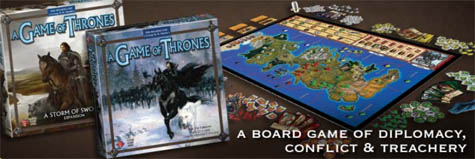
Armies and navies gather under the banners of the great houses; the Iron Throne is contested, Wildings are gathering strength beyond the northern wall, a clash of kings is about to begin. It will take more than military might to seize the throne, the tools of diplomacy, intrigue, power and wealth will play their parts in equal measure.
AGoT – the Board Game was designed by Christian Peterson (Twilight Imperium 3) and Kevin Wilson (Arkham Horror) for 3 to 5 players although it plays best with 5. Let me start off with saying this game was a huge hit with my group including a number of players that have not read the books. At four hours playing time the game is long but the time just seems to fly by. AGoT – the Board Game is a tense, white knuckle experience from start to finish with agonizing choices being made at every moment. A well integrated turn sequence keeps all players engaged with no sense of downtime waiting for others to finish their turn.
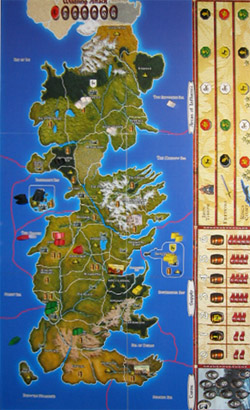 Game play:
Game play:
The game board is a map of Westeros that spans from the Wall in the north to the Summer Seas in the south with land and sea areas divided into territories or regions. Each player rules one of the great houses; in the base game House Lannister, House Greyjoy, House Stark, House Baratheon, and House Tyrell. The object of the game is deceptively simple, control a combination of 7 cities and strongholds or have the most by the end of turn 10. Achieving this goal is anything but simple, resources are very limited and lack of supplies can greatly limit the size of armies. Players will often find themselves neighboring two or more houses and will have to carefully manage alliances with some while aggressively pressing the attack against others.
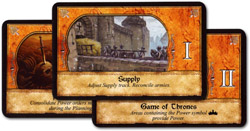
Each turn begins with 3 event cards drawn from the Westeros event decks. Most of the event cards modify game play slightly and add thematic interest; however, four types of cards (Supply, Muster, Wilding Attack, and Clash of Kings) are considerably more involved and drive the pacing of the game. The order and frequency with which these cards are drawn will greatly affect player strategy and go a long way toward making each game session unique.
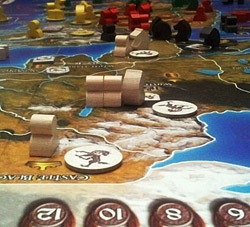 Supply and muster events influence the military aspect of the game. A supply event changes the number and size of armies each house can support based upon the supply producing territories they control. A muster event allows houses to raise armies consisting of footmen, knights, and ships which can be used to invade new territories and defend those already taken. The number of new armies gained through each muster event is determined by the number of strongholds and cities controlled and must conform to supply limits at all times.
Supply and muster events influence the military aspect of the game. A supply event changes the number and size of armies each house can support based upon the supply producing territories they control. A muster event allows houses to raise armies consisting of footmen, knights, and ships which can be used to invade new territories and defend those already taken. The number of new armies gained through each muster event is determined by the number of strongholds and cities controlled and must conform to supply limits at all times.
In the event of a Wilding attack each house must contribute power tokens (a currency accumulated through a form of taxation) in support of the Night’s Watch. The amount contributed is secretly decided by each player and then totaled in a simultaneous reveal. Houses can gamble with low contributions and try to conserve their supply of power tokens but if the total isn’t sufficient to turn back the Wilding attack, all players lose forces with the lowest contributor losing twice as much as the other houses.
A Clash of Kings represents political struggle where a reserve of wealth is particularly important. When a Clash of Kings event card is revealed players must bid with power tokens for temporary ranking on each of the three seats of power and influence. Ranking on the Iron Throne determines turn order, allowing higher ranked houses to execute orders before lower ranked houses. Higher ranking on the Fiefdoms track provides advantage in battle. Ranking in the King’s Court represents spies and intrigue and provides houses with more flexibility when issuing orders to armies. Holding the top position in each ranking provides additional benefits as well.
After events are resolved players simultaneously issue orders to armies by placing order tokens face down on the map. March orders allow armies to move and invade territories. Defend orders allow armies to brace for attack. Support orders allow armies to apply their strength in adjacent territories, including supporting battles between other houses. Consolidating power taxes territories to accumulate power tokens, while raid orders allow armies to thwart plans by removing the adjacent orders of other houses.
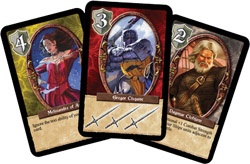 Combat occurs whenever an army advances into a territory occupied by another house. Combat is simple and completely dice free; strength points are totaled, 1 for each footman and ship, two for each knight. Each house also starts the game with a hand of cards which can contribute points to the battle. These cards are selected in secret and simultaneously revealed to arrive at a total strength with the higher total winning. A wrinkle in this process is that house cards cannot be replayed until they have all been used, so each player wants to pick the lowest valued card that will still result in success. House cards may also carry special abilities which modify various aspects of the battle, such as increasing the value of a knight to 3, or allowing a winning army to recover a discarded house card. Another factor to keep in mind, adjacent armies from other houses with support orders can throw their support behind either side in a battle which is often sufficient to determine the outcome.
Combat occurs whenever an army advances into a territory occupied by another house. Combat is simple and completely dice free; strength points are totaled, 1 for each footman and ship, two for each knight. Each house also starts the game with a hand of cards which can contribute points to the battle. These cards are selected in secret and simultaneously revealed to arrive at a total strength with the higher total winning. A wrinkle in this process is that house cards cannot be replayed until they have all been used, so each player wants to pick the lowest valued card that will still result in success. House cards may also carry special abilities which modify various aspects of the battle, such as increasing the value of a knight to 3, or allowing a winning army to recover a discarded house card. Another factor to keep in mind, adjacent armies from other houses with support orders can throw their support behind either side in a battle which is often sufficient to determine the outcome.
Conclusions:
Some reviewers have compared AGoT – the Board Game to the classic Avalon Hill game Diplomacy with drawn out negotiation sessions for alliances and brutal back-stabbing often determining the winner. Other reviewers claim to play without any alliances at all. Frankly, I think both approaches miss the mark. To play without any attention to alliances would lose much of the flavor of the books and produce a fairly dry game. On the other hand, unlike Diplomacy, alliances in AGoT – the Board Game are simple, short-term agreements and often negotiated openly. Alliances and negotiation are important parts of the game, but they’re not the entire game…there’s plenty of other interesting mechanics at work to produce a truly nail-biting epic experience.
A Game of Thrones – the Board Game may be purchased from full service game stores and online for about $40.00 – $50.00. Supplies may be somewhat limited at this time, however, Fantasy Flight Games is in the process of reprinting this game.
A Game of Thrones – the Living Card Game
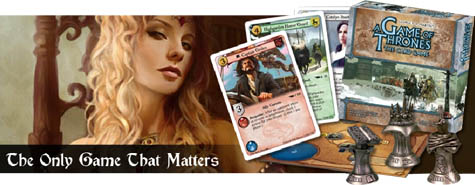
Once again players are cast in the roles of rulers of the great houses of Westeros, vying for the Iron Throne, this time in the form of a 2 to 4 player card game that plays in about one hour.
In the interest of full disclosure, I have only played this game once, and a long time ago at that. Fantasy Flight Studios (the video division of Fantasy Flight Games) has produced a 10 part video tutorial that explains the game far more accurately and in more detail than I could achieve here. I’ve included the introduction in this post, the remaining parts may be found here.
AGoT – The Card Game was originally introduced as a collectable deck construction game, sold very much like Magic: The Gathering with starter sets and small, randomly packed boosters. AGoT – The Collectible Card Game was a deep, interesting to play, well designed game but enjoyed only modest success against MtG and other well established collectable card games. The gaming market just didn’t have the stomach for yet another expensive card collecting habit.
Recognizing that AGoT – The Collectible Card Game had solid mechanics and something interesting to offer the gaming community, Fantasy Flight Games relaunched the game in a new format, the Living Card Game or LCG (also known as a limited card game). What sets LCGs apart from CCGs is how they are packaged for sale. LCG’s are sold as large core sets or small chapter packs. Either way, the box contains a fixed set of cards without any random distribution or blind buying. The core sets include four playable, pre-constructed decks, the chapter packs usually require a core set for use. Strangely, the lack of random booster packs eliminates the unfortunate economics of CCG’s and has made the LCG format a success, so much so that Call of Cthulhu and the new, highly anticipated Lord of The Rings card games both sport the LCG format.
A Game of Thrones – The Living Card Game may be purchased from full service game stores and online for about $27.00 Chapter packs typically run around $7.00 each.
When not playing games, Bob Gallo is a computer programmer specializing in Flash and interactive application design living in the Charlotte, NC area. Bob got his gaming start in the mid 1970s with traditional hex-and-counter war games and has played nearly all types of games including role playing games, miniatures, collectible card games, video/PC games as well as traditional board and card games.











I got the GoT board game along with other promotional stuff from a friend at a cable company. I’ve checked it out but haven’t sat down to play. I used to love Diplomacy so looking forward to this.
Rob
It’s a great game, play it with 5 if possible. If you’re playing with serious gamers I’d also suggest downloading the FAQ from FFG. House Lannister starts the game surrounded by enemies, a very small change to the game setup evens out the playing field.
The GoT board game is indeed awesome. Trying to get a group together to play it again soon.
I loved Diplomacy – this has me quite interested…
Definitely try out the board game, it’s really good. The more players the better, and I think there is an expansion pack that allows even more players, and gives new house cards and better rules for sea battle. Can’t remember what it’s called, but the board game really is great.
I like the idea of Diplomacy, but the actual games I’ve played (online and in person) have been less than ideal.
The ordering of armies for movement and support in GoT is basically the same as Diplomacy, but it is streamlined by placing facedown orders, so you know that a unit is up to something, but you don’t know what until orders are revealed. The back room negotiating is the same – we do a lot of note passing.
The blind bidding for the Throne, Fiefdoms, and Court order is a wonderful mechanic and also plays heavily into the scheming and negotiation (“I won’t bid for the Throne if you’ll support my attack on Winterfell next turn” and things like that). The theme is wonderfully integrated. The only real random element in the game is the Westeros Events Deck, but for the most part, these events affect every player and bad things mainly happen when you’re taking risks.
The board game is terrific. One of the things that impressed me from the very start was how true it felt to the novels. The abilities of each House really fits the novels remarkably well.
Unfortunately, I’ve had a really hard time finding players. I’ve managed to play with five people a couple of times but several of them hadn’t read the novels and they didn’t enjoy it as much as those of us who had. It’s spent the last several years in my closet simply because I can’t get a big enough group of people to play it, which makes me very sad.
I was a playtester for the CCG but it turns out that I’m not really a CCG kind of guy so I never played it after it was released. I’m glad they came out with a different way of dealing with that.
For the record, there are two expansions for AGoT – the Board Game, listing for $39.95 each. The base game is excellent on its own but from what I understand these are nice additions for experienced players:

AGoT: A Clash of Kings adds components and a map overlay for a 6th player; House Martell, introduces port rules (which may be used without the expansion to moderate the power of navies), introduces two new units; siege engines and fortifications, and increases the power range of the house cards.

AGoT: A Storm of Swords provides a new map designed specifically for 4 players, introduces leaders with the option to capture, tactics cards to add more variety to combat, new house cards, and an alternative Westeros event deck.
@toryx check out the Storm of Swords expansion. It has a new map detailing the Trident riverlands, designed specifically for four players. I have a brief comment on both expansions which should post here shortly as soon as tor admin clears it.
I think I’m convinced. I was looking for card games or board games that weren’t as involved as roleplaying games, but had aspects of storytelling to them. This goes perfectly along with my first reading of A Song of Fire and Ice, and the HBO show.
@Sharat, these are great games that really capture the political wheeling and dealing in Westeros, but if you want something storytelling / RPG-Lite you should also check out Mansions of Madness, Dan Wells did a review here on tor.com just recently.
Excellent article! Feel free to try out my Board Game App at http://www.facebook.com/webofthrones once you’ve gotten the hang of the rules.
It’s a work in progress; the login screen looks fugly and there’s no in-game chat yet so you should bring friends, but the Game itself looks rather nice if I do say so myself. Any feedback and/or bug reports would be welcome on the FB page above!
Best regards and have fun playing,
-JS